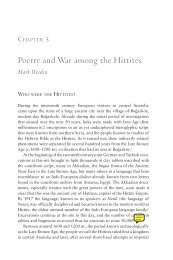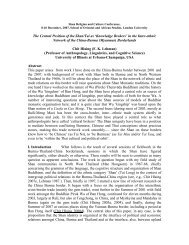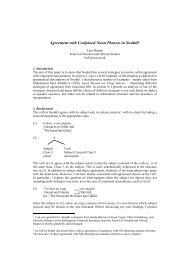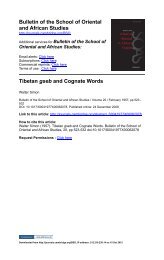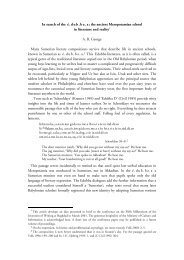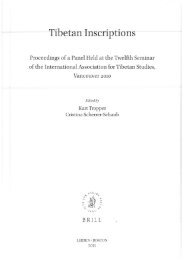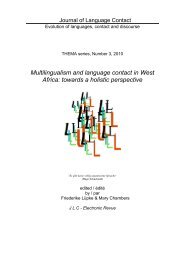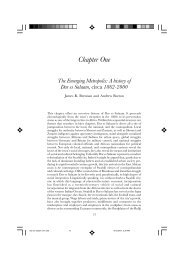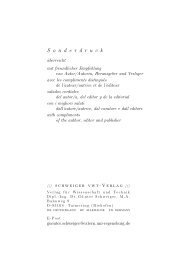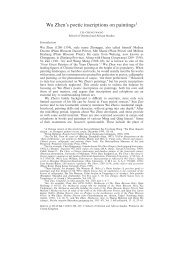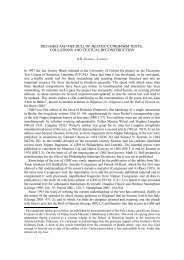Literarische Stoffe - The School of Oriental and African Studies
Literarische Stoffe - The School of Oriental and African Studies
Literarische Stoffe - The School of Oriental and African Studies
Create successful ePaper yourself
Turn your PDF publications into a flip-book with our unique Google optimized e-Paper software.
106<br />
Almut Hintze<br />
44.15 h•m sp¡d¡ … jama t . 21 A connection <strong>of</strong> -spaþ- with sp¡da-/sp¡Ña- ‘army’ could be<br />
supported by the latter’s YAv. collocation with maiÑii¡na-, maiÑii¼na- ‘middle’ in Yt 10.36.<br />
However, the main obstacles to identifying the word sp¡da-/sp¡Ña- ‘army’ in the compound<br />
hamaspaþma daiia- are <strong>of</strong> a morpho-phonemic nature. Apart from the fact that the compound<br />
has a form with a short a <strong>and</strong> with þ, not Ñ, one would expect it to preserve the thematic vowel<br />
<strong>of</strong> sp¡da-/sp¡Ña-. Moreover, even if allowance was made for the stem forming vowel to drop,<br />
the cluster dm would become nm in YAv., cf. OAv. dçm¡na- ‘house’, YAv. nm¡na-. 22 For these<br />
reasons -spaþ- in hamaspaþma daiia- cannot be sp¡da-/sp¡Ña- ‘army’. <strong>The</strong> assonance <strong>of</strong> the<br />
Gathic words h•m sp¡d¡ … jama t with hamaspaþma daiia- is purely accidental <strong>and</strong> the<br />
connection <strong>of</strong> the name with sp¡h ‘army’ in the Middle Persian literature is the product <strong>of</strong> a<br />
popular etymology which may have been inspired by the Gathic passage. 23<br />
In 1938, Ernst Herzfeld adduced the form sp¡þmaida- which he read in the OP<br />
inscription DNb 30–31 <strong>and</strong> rendered as ‘military camp’. This was believed to provide decisive<br />
support for the equation <strong>of</strong> Av. -spaþ- with MP sp¡h. 24 For over forty years the OP ghost word<br />
then misled scholars until in 1979 Ilya Gershevitch demonstrated that it was based on a<br />
wrong reading <strong>of</strong> the OP signs <strong>and</strong> therefore non-existent. 25 Gershevitch himself interpreted<br />
hamaspaþma daiia- as ‘the time <strong>of</strong> bestirment’, an agricultural term marking “the end <strong>of</strong><br />
retirement or the end <strong>of</strong> the oÙ-season, <strong>and</strong> the beginning <strong>of</strong> outdoor or Ÿeld work” (p. 294)<br />
viewing it as a compound *ham-¡-spat-ma-ida²a-. He considered the Ÿrst term to be a m<strong>and</strong>erivative<br />
from the verb*ham-¡-spat- ‘to bestir oneself’ <strong>and</strong> the second, *ida²a- meaning ‘time’,<br />
an -a²a-derivative from the root i ‘to go’ subsequently enlarged by an Indo-Iranian sufŸx *-dh-.<br />
However, this explanation has also remained unconvincing not only because there is no<br />
evidence in Indo-Iranian for an enlarged root *idh-, 26 but also because the meaning ‘time’ is<br />
pleonastic since hamaspaþma daiia- itself is an adj. which characterizes a word for ‘time’, ratu-.<br />
21 Darmesteter 1892–93, I 40f. with fn. 15 ( “réunion des armées [des âmes]”) <strong>and</strong> 292 fn. 46.<br />
22 On the treatment <strong>of</strong> dm in YAv. see HoÙmann & Forssman 1996, 97.<br />
23 That the Pahlavi interpretation <strong>of</strong> hamaspaþma daiia- results from popular etymology has been suggested by<br />
several scholars, but without reference to the Gathic passage as its source: see the references by Bielmeier<br />
1992, 34.<br />
24 Herzfeld 1938, 8, 310–315.<br />
25 Gershevitch 1979, 291 instead reads sp¡ya(n)tiyåy¡, which was adopted by Schmitt 2000, 34, 36, 39, 40<br />
<strong>and</strong> translated ‘in battle’; on the reading <strong>of</strong> the OP signs see also Schmitt 1997, 271–273. Based on<br />
Herzfeld’s reading <strong>of</strong> the OP word, Bailey 1959, 138–140 interprets hama-spaþ-ma daiia- as ‘gathering to<br />
a beer feast’ in autumn, but later relinquishes the connection <strong>of</strong> hama- with Skt. samit¡ ‘wheat- our’ (Prolexis<br />
to the Book <strong>of</strong> Zambasta. Cambridge: CUP 1967, 408). Kellens’, Noms-racines 15 fn. 2 discussion <strong>of</strong><br />
hamaspaþma daiia- is another example <strong>of</strong> how the OP ghost word misled scholars.<br />
26 Cf. Bielmeier 1992, 37f., who on pp. 34–36 discusses other explanations that have been proposed for<br />
hamaspaþma daiia-.



